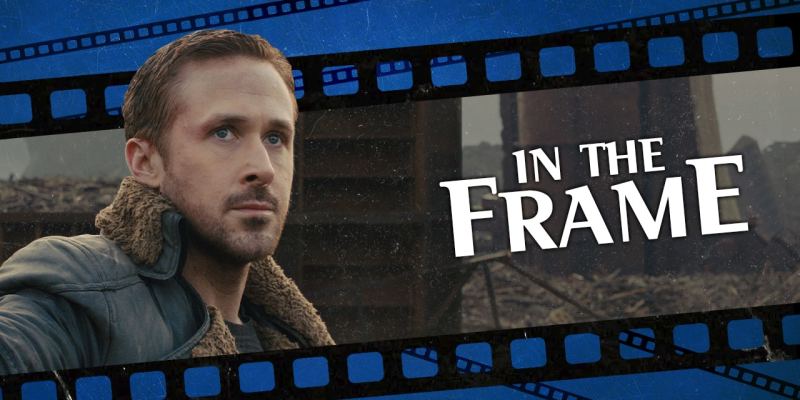Note: Blade Runner 2049 is three years old this week, so we thought it was worth a look back at it. This article contains spoilers for Blade Runner 2049.
At the end of Blade Runner 2049, Rick Deckard (Harrison Ford) stands outside the laboratory housing his lost daughter, Dr. Ana Stelline (Carla Juri). Deckard asks the replicant K (Ryan Gosling) about the sacrifices that the younger man made to get them here. “Why?” Deckard asks. “Who am I to you?” K shrugs off the question. “Go meet your daughter,” K instructs. Deckard heads inside; K rests in the snow. The sequence is ambiguous, but screenwriter Michael Green has suggested K dies in the snow.
K does not respond to Deckard’s question, but the audience already knows the answer: K is nothing to Deckard. The two men are complete strangers who had only met a day or so earlier in the ruins of Las Vegas. K had no idea who Deckard was before he took on the case that drives Blade Runner 2049: an investigation spurred by the discovery of an ossuary containing the remains of the replicant Rachael (Sean Young). K sacrifices his life to unite a complete stranger with his daughter.
Of course, Blade Runner 2049 repeatedly and consciously gestures towards a stronger connection. When it is discovered that Rachael gave birth before her death – an event that multiple characters frame as “a miracle” – the film consciously and repeatedly hints that K might be the child of Rachel and Rick Deckard. “I always knew you were special,” states K’s holographic companion Joi (Ana de Armas). “Maybe this is how: a child, of woman born, pushed into the world, wanted, loved.”
Blade Runner 2049 sets up an epic story. There are repeated references to the events that have shaped the film’s world: the destruction of Las Vegas by a “dirty bomb,” the erasure of all computer records in Los Angeles during “the Blackout.” These events are explored in supplementary material, but the film leaves details vague, similar to how George Lucas wove references to things like “the Kessel Run” or “the Clone Wars” into Star Wars to make the film’s universe seem bigger.

Characters within Blade Runner 2049 frame the film’s stakes in epic terms. On discovering that a replicant might have given birth, Lt. Joshi (Robin Wright) curses, “Am I the only one who can see the fucking sunrise here? This breaks the world, K.” When Luv (Sylvia Hoeks) arrives to announce the creation of a new replicant, industrialist Niander Wallace (Jared Leto) chides her, “An angel should never enter the kingdom of heaven without a gift. Can you at least pronounce, ‘A child is born?’”
In its opening two hours, Blade Runner 2049 peddles in the clichés of the familiar “hero’s journey” as outlined by Joseph Campbell and as codified for an entire generation for George Lucas’ Star Wars. There are even recurring suggestions of a replicant resistance organized by Freysa (Hiam Abbass) and including Mariette (Mackenzie Davis) and Sapper Morton (Dave Bautista), something far more ambitious and far-reaching than the five replicant fugitives in the original Blade Runner.
However, in its final 45 minutes, Blade Runner 2049 swerves sharply, avoiding the dramatic payoffs of an epic narrative. Niander Wallace faces no consequences for any of his actions, the ending representing a minor inconvenience to the corporate overlord. Freysa’s resistance remains in the shadows. Despite Joshi’s fears, the world does not crack open. Despite “the miracle,” there is no replicant revolution. Instead, the stakes at the climax of Blade Runner 2049 are more intimate.
Given that Blade Runner 2049 released in a market dominated by franchise films and recycled intellectual property, it is possible that these elements were all being set up for a planned sequel. In pre-release interviews, Denis Villeneuve teased, “Blade Runner could go on.” Even after the film’s underwhelming box office returns seemed to kill any prospect of a sequel, Villeneuve confessed that a hypothetical sequel still haunts him: “I wake up sometimes in the night dreaming about it.”

Even allowing for this, Blade Runner 2049 pointedly rejects the most obvious cliché of epic narratives: the “chosen one.” K spends a significant portion of Blade Runner 2049 believing that he is the “miracle” child of Rachael and Deckard, only to have that belief brutally dismantled towards the film’s climax. Freysa is not without compassion. “You imagined it was you? You did. You did. We all wish it was us.” K is not anybody special. He is not a messiah. He is just another “skinjob.”
In this sense, Blade Runner 2049 is a very millennial story. Although “chosen one” narratives date back (at least) to the myth of Perseus from Ancient Greece, they were particularly common in the pop culture of the 1980s and into the 1990s. After all, it was The Empire Strikes Back that established Luke Skywalker (Mark Hamill) was the son of Darth Vader (David Prowse and James Earl Jones) and set the trend for the generation.
It is interesting to wonder how this trend emerged when it did. Perhaps it emerged in response to the disillusionment of Watergate and Vietnam in the 1970s, or it tapped into the same yearning for a brighter predetermined future suggested by Ronald Reagan’s “morning in America.” Maybe it mirrored the ascent of the religious right or developed as a reaction to it. What is David Lynch’s Dune but a secular religious epic? What is The Terminator but a secular version of the nativity?
The trend continued into the 1990s, with J.K. Rowling’s Harry Potter books and the Wachowksis’ The Matrix updating the trope for a new generation. Star Trek: Deep Space Nine introduced Commander Benjamin Sisko (Avery Brooks) as “the Emissary to the Prophets,” communing between the planet Bajor and its gods. On The X-Files, the grand government conspiracy was entangled with the family tree of Fox Mulder (David Duchovny), at one point crucified on a lab table.

In a decade marked by the existential ennui of “the end of history,” these narratives of destiny and purpose were comforting and reassuring. However, at the turn of the millennium, there was a growing sense of disenfranchisement. Fight Club rejected the idea that its characters were anything but “the middle children of history,” with Tyler Durden assuring his audience that they are “not a beautiful and unique snowflake.” In the Star Wars prequels, George Lucas deconstructed the trope.
It’s interesting that many of the belated and delayed sequels to so many of these older 1980s and 1980s franchises should deconstruct this idea of “the Chosen One,” films like Bill & Ted Face the Music. Indeed, Blade Runner 2049 was not the only legacy sequel to employ this trope in 2017. Despite rampant speculation that Rey (Daisy Ridley) must be related to an existing Star Wars character, The Last Jedi made a similarly bold assertion that Rey was “Rey from Nowhere.”
This speaks to Millennial anxieties. While the generation that came of age with the culture of the 1980s and 1990s was seen as “balking at work, marriage and baby-boomer values,” they turned out to be surprisingly influential – culturally, politically, and economically. In contrast, Millennials have found themselves struggling; they lived through two once-in-a-lifetime recessions, they struggle to own homes and start families, they question the founding assumptions of American culture.

Blade Runner 2049 is a movie that understands this malaise felt by a generation raised on the promise of exceptionalism only to see it go sour. There’s a recurring cynicism in Blade Runner 2049 about these myths. When K asks why Stelline gave him memories of a childhood he never lived, she explains that these narratives “maintain a stable product.” K falls in love with Joi, but she is a product, not a person. She is a fantasy sold to him, offering him the illusion of domestic bliss.
Packaging the simulacra of a normal life keeps K compliant. The myth of epic struggle turns him into an instrument to be used by others: Joshi hopes to use him to kill the “miracle” child, while Wallace hopes to track him to find her. Even towards the end, Freysa tries to use K as a weapon, trying to convince him to kill Deckard to protect the child. None of these epic myths actually serve K. Instead, they reduce him to a cog in somebody else’s narrative. The epic is always somebody else’s story.
In the end, Blade Runner 2049 rejects the epic myth. It doesn’t matter that K is not the replicant messiah and that he won’t lead a revolution. Instead, K commits himself to a more modest and achievable goal. He makes a personal choice to sacrifice his life to reunite a father with his long-lost daughter, two people that K didn’t even know before the start of the movie. K spends most of the movie hoping that he might be a “real” person (“born — not made”), but it’s this tiny-in-the-grand-scheme-of-things choice that ultimately defines him.
In the end, lying out there in the snow, K demonstrates that he has as much humanity as any character in Blade Runner 2049. That is what really matters.
